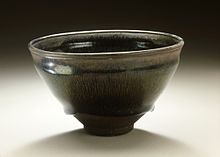Chawan
| Chawan | |||||||||||

Chawan with hare's fur pattern, Jian ware, from China during the Song dynasty (Los Angeles County Museum of Art)
|
|||||||||||
| Historical name (Classical Chinese) | |||||||||||
|---|---|---|---|---|---|---|---|---|---|---|---|
| Chinese | 茶碗 | ||||||||||
| Literal meaning | "tea bowl" | ||||||||||
|
|||||||||||
| Chinese name | |||||||||||
| Traditional Chinese | 茶盞 | ||||||||||
| Simplified Chinese | 茶盏 | ||||||||||
| Literal meaning | "tea cup" | ||||||||||
|
|||||||||||
| Korean name | |||||||||||
| Hangul | 다완 | ||||||||||
| Hanja | 茶碗 | ||||||||||
| Literal meaning | "tea bowl" | ||||||||||
|
|||||||||||
| Japanese name | |||||||||||
| Kanji | 茶碗 | ||||||||||
| Kana | ちゃわん | ||||||||||
|
|||||||||||
| Transcriptions | |
|---|---|
| Middle Chinese | |
| Middle Chinese | /ɖˠa.ʔuɑnX/ |
| Old Chinese | |
| Zhengzhang | /*rlaː.qoːnʔ/ |
| Transcriptions | |
|---|---|
| Standard Mandarin | |
| Hanyu Pinyin | cházhăn |
| Wade–Giles | ch'a2chan3 |
| Transcriptions | |
|---|---|
| Revised Romanization | dawan |
| McCune–Reischauer | tawan |
| Transcriptions | |
|---|---|
| Revised Hepburn | chawan |
A chawan (茶碗; literally "tea bowl") is a bowl used for preparing and drinking tea. There are many types of chawan used in East Asian tea ceremonies. The choice of their use depends upon many considerations.
The chawan originated in China. The earliest chawan in Japan were imported from China between the 13th through the 16th century.
The Jian chawan, a Chinese tea bowl known as Tenmoku chawan in Japan, was the preferred tea bowl for the Japanese tea ceremony up until the 16th century. In Japan, tea was also mainly drunk from this Chinese variety of tea bowls up till about the 15th century. The Japanese term tenmoku is derived from the name of the Tianmu Mountain, where Japanese priests acquired these tea bowls from Chinese temples to bring back to Japan according to tradition.
An 11th-century resident of Fujian wrote about the Jian tea wares:
By the end of the Kamakura period (1185–1333), as the custom of tea drinking spread throughout Japan and the Tenmoku chawan became desired by all ranks of society, the Japanese began to make their own copies in Seto (in present-day Aichi Prefecture). Although the Tenmoku chawan was derived from the original Chinese that came in various colors, shapes, and designs, the Japanese particularly liked the bowls with a tapered shape, so most Seto-made Tenmoku chawan had this shape.
With the rise of the wabi tea ceremony in the late Muromachi period (1336–1573), the Ido chawan, a variety of Korean bowls mainly used for rice in Korea, also became highly prized in Japan. Korean bowls were a favourite of Sen no Rikyu because of their rough simplicity.
With time and development of the Japanese tea ceremony as a distinct form, local ceramics became more priced and developed. Around the Edo period, the chawan was often made in Japan. The most esteemed pieces for a tea ceremony chawan are Raku ware, Hagi ware and Karatsu ware. There is a saying in the tea ceremony schools for the preferred types of chawan: "Raku first, Hagi second, Karatsu third."
...
Wikipedia
